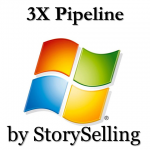 With the rise of the empowered buyer, it is no wonder that Microsoft, and SAP have embraced insight selling. But these companies have also learned that there is a gap between theory and the practical application, because insight selling is more than just using data, facts, and brilliance to shock and awe buyers about the error of their ways.
With the rise of the empowered buyer, it is no wonder that Microsoft, and SAP have embraced insight selling. But these companies have also learned that there is a gap between theory and the practical application, because insight selling is more than just using data, facts, and brilliance to shock and awe buyers about the error of their ways.
Insight Selling
Details could increase the impact of your argument by 34.9%
Why customers get stuck in analysis paralysis & how to avoid it

After working on Wall Street for 14 years, I’ve always presented facts and figures to B2B buyers, because that’s how I felt serious business people made decisions. This belief was backed by 2500-years of conditioning. It started when Plato said that man is rational, and that it’s our emotions that interfere with rational decisions. But recently I had an experience that called this belief into question. And then shortly thereafter, I was presented with a compelling study from neuroscience that also refuted this belief. So when these two events collided, the myth that buying decisions were strictly rational was busted. I now understood why customers get stuck in analysis paralysis, and what I could do to help then to avoid it.
Insight Selling- what is insight, and why do it?
 Everyone is talking about how sales & marketing must now learn how to deliver insights to their customers, because the internet has changed how people buy. So by the time a customer now engages a salesperson, they’re already 60% of the way through their buying cycle, because they’ve done most of their research online. So they don’t need more information from a salesperson. What they need is insight into what the information means.
Everyone is talking about how sales & marketing must now learn how to deliver insights to their customers, because the internet has changed how people buy. So by the time a customer now engages a salesperson, they’re already 60% of the way through their buying cycle, because they’ve done most of their research online. So they don’t need more information from a salesperson. What they need is insight into what the information means.
But what is insight, why is it important, and how do you deliver it?
Insight Selling- Challenger Sale or Fail?

How do you deliver insight to your customers so that it challenges the status quo without challenging the customer?
Well, when you get sick, do you ever go onto WebMD before you visit the Doctor? So when you show up at the doctor’s office, all you want him to do is to write you a prescription for what you feel you need? And if the market for buying prescription medicine was truly competitive, wouldn’t you also be looking for a better price?
CEO of SAP recruits a Chief Storyteller- why?
 When the world’s largest business software company hires a Chief Storyteller, its news, because it’s a first for the industry.
When the world’s largest business software company hires a Chief Storyteller, its news, because it’s a first for the industry.
And when the decision was made by SAP’s CEO, Bill McDermott, it becomes a great story.
- Why, for instance, did Bill feel that the role of Chief Storyteller was so important that he personally recruited Julie Roehm 18-months ago for the role?
- Why did he hire a B2C candidate for a B2B role?
- And with all of Bill’s experience (Sales Xerox, President Gartner, Exec VP of WW Sales & Operations Siebel, and CEO SAP), what insights can we gain from his decision?
Salesman conquers his fear of rejection with the latest tools
 Joel needed new customers. But he found that he wasn’t 100% committed when he picked-up the phone, because his fear of rejection made him apprehensive. It felt like he had one foot on gas, and the other on the brake. And because customers sensed that Joel wasn’t completely sold, they weren’t interested in what he was selling, because no one wants to be rescued by a drowning man.
Joel needed new customers. But he found that he wasn’t 100% committed when he picked-up the phone, because his fear of rejection made him apprehensive. It felt like he had one foot on gas, and the other on the brake. And because customers sensed that Joel wasn’t completely sold, they weren’t interested in what he was selling, because no one wants to be rescued by a drowning man.
So Joel’s turned to his VP of Sales for advice, but he didn’t find being told to ‘just suck it up and make the calls’ particularly helpful.
Fortunately Joel loved to read, and he was shocked to discover that his fear of calling new clients was due to an overactive instinct of survival.
Pipeline up 3X largely due to StorySelling.
 One of Microsoft’s largest partners “…increased their pipeline by exactly 3-times in under 18-months largely due to StorySelling. ”
One of Microsoft’s largest partners “…increased their pipeline by exactly 3-times in under 18-months largely due to StorySelling. ”
Two years ago Gord Smith, a Partner at Ideaca (one of Microsoft’s largest partner in Canada), hired a bunch of new salespeople to hunt for new business, because he knew the partners were too busy servicing clients (click for video).
“You’re in sales, you’re too stupid to understand.”

When I asked for more details on how a customer could use our product, Tim, our Managing Director, joked: “Michael, you’re in sales, you’re too stupid to understand.” But the sad thing was that this was what he, and his delivery team really believed. And when I wanted customer stories, I only got the watered down versions from marketing. Because marketing didn’t trust sales to properly share these stories with customers, they had the executive team sand off the rough corners that made the stories interesting- to the point that they were useless. So there I was standing outside the walls of customer knowledge, trying to prepare for a potential customer meeting with the few scraps of information management decided to throw down to sales.
McKinsey Study: Solution Selling… is the pain worth the gain?
 “Solutions selling has been all the rage over the last 5 to 10 years, yet 75 percent of the companies that attempt to offer solutions fail to return the cost of their investment.” (Source: ‘Solution Selling: Is the pain worth the gain’ McKinsey Study).
“Solutions selling has been all the rage over the last 5 to 10 years, yet 75 percent of the companies that attempt to offer solutions fail to return the cost of their investment.” (Source: ‘Solution Selling: Is the pain worth the gain’ McKinsey Study).
Even the author and founder of Solution Selling & CustomerCentric Selling, Mike Bosworth, agrees.
“The number one complaint I heard from sales managers was that the bottom 80 percent of their salespeople quit trying to use the methodology within 10 days of the workshop.” (‘Mike’s Ah-Ha moment’ Sept. 2011).

